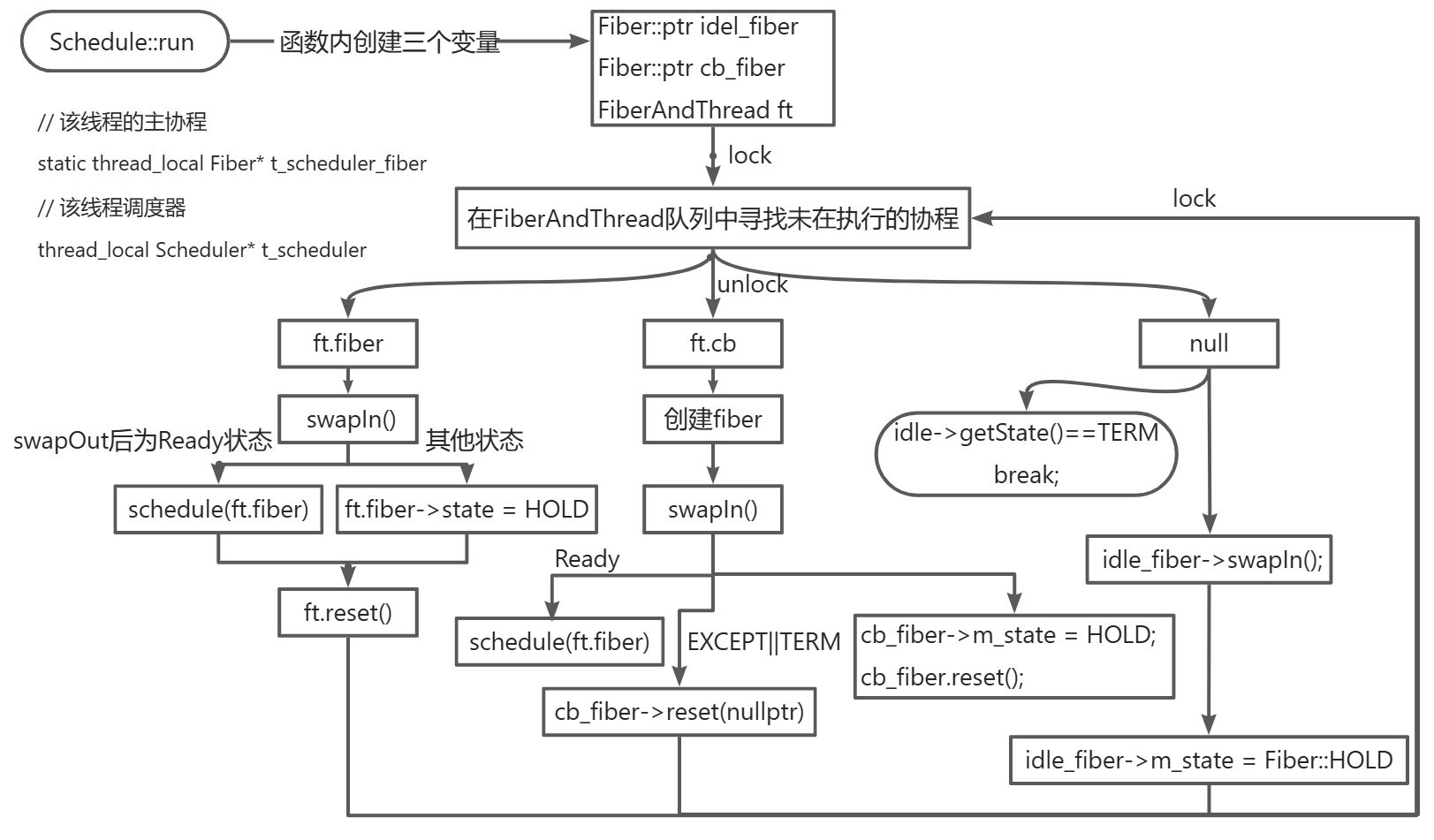整体思路
创建N个线程,有M个协程,scheduler会调度N个线程执行M个协程的任务
- 创建
Schedule类,传入需要的线程数量,是否使用当前线程作为主线程,线程名
- 调用
Schedule::start()方法,根据线程数量创建线程,加入线程队列vector<Thread::ptr>
- 线程执行
bind(&Scheduler::run, this)方法
- 该方法循环查找协程队列中待执行的协程或方法
- 调用
Schedule::schdule()方法,传入函数或协程,加入调度队列list<FiberAndThread>
- 调用
Schedule::stop()方法结束
成员变量
1
2
3
4
5
6
7
8
9
10
11
12
13
14
15
16
| class Scheduler {
private:
MutexType m_mutex;
std::vector<Thread::ptr> m_threads;
std::list<FiberAndThread> m_fibers;
Fiber::ptr m_rootFiber;
std::string m_name;
protected:
std::vector<int> m_threadIds;
size_t m_threadCount = 0;
std::atomic<size_t> m_activeThreadCount = { 0 };
std::atomic<size_t> m_idleThreadCount = { 0 };
bool m_stopping = true;
bool m_autoStop = false;
int m_rootThread = 0;
};
|
成员函数
1
2
3
4
5
6
7
8
9
10
11
12
13
14
15
16
17
18
19
20
21
22
23
24
25
26
27
28
29
30
31
32
33
34
35
36
37
38
39
40
41
42
43
44
45
46
47
48
49
50
51
52
53
| class Scheduler {
public:
Scheduler(size_t threads = 1, bool use_caller = true, const std::string& name = "");
virtual ~Scheduler();
const std::string& getName() const { return m_name; }
void start();
void stop();
template<class FiberOrCb>
void schedule(FiberOrCb fc, int thread = -1) {
bool need_tickle = false;
{
MutexType::Lock lock(m_mutex);
need_tickle = scheduleNoLock(fc, thread);
}
if (need_tickle) {
tickle();
}
}
template<class InputIterator>
void schedule(InputIterator begin, InputIterator end) {
bool need_tickle = false;
{
MutexType::Lock lock(m_mutex);
while (begin != end) {
need_tickle = scheduleNoLock(&*begin, -1) || need_tickle;
++begin;
}
}
if (need_tickle) {
tickle();
}
}
void switchTo(int thread = -1);
std::ostream& dump(std::ostream& os);
protected:
virtual void tickle();
void run();
virtual bool stopping();
virtual void idle();
void setThis();
bool hasIdleThreads() { return m_idleThreadCount > 0; }
private:
template<class FiberOrCb>
bool scheduleNoLock(FiberOrCb fc, int thread) {
bool need_tickle = m_fibers.empty();
FiberAndThread ft(fc, thread);
if (ft.fiber || ft.cb) {
m_fibers.push_back(ft);
}
return need_tickle;
}
};
|
start、stop
start创建线程,指定执行函数run,将线程加入到线程池vector<Thread::ptr>中stop结束线程,设置自动停止m_autoStop为true,设置正在停止m_stopping为true,结束线程join()1
2
3
4
5
6
7
8
9
10
11
12
13
14
15
16
17
18
19
20
21
22
23
24
25
26
27
28
29
30
31
32
33
34
35
36
37
38
39
40
41
42
43
44
45
46
47
48
49
50
51
52
53
54
55
56
57
58
59
60
61
62
63
| void Scheduler::start() {
MutexType::Lock lock(m_mutex);
if (!m_stopping) {
return;
}
m_stopping = false;
SYLAR_ASSERT(m_threads.empty());
m_threads.resize(m_threadCount);
for (size_t i = 0; i < m_threadCount; ++i) {
m_threads[i].reset(new Thread(std::bind(&Scheduler::run, this)
, m_name + "_" + std::to_string(i)));
m_threadIds.push_back(m_threads[i]->getId());
}
lock.unlock();
}
void Scheduler::stop() {
m_autoStop = true;
if (m_rootFiber
&& m_threadCount == 0
&& (m_rootFiber->getState() == Fiber::TERM
|| m_rootFiber->getState() == Fiber::INIT)) {
SYLAR_LOG_INFO(g_logger) << this << " stopped";
m_stopping = true;
if (stopping()) {
return;
}
}
if (m_rootThread != -1) {
SYLAR_ASSERT(GetThis() == this);
}
else {
SYLAR_ASSERT(GetThis() != this);
}
m_stopping = true;
for (size_t i = 0; i < m_threadCount; ++i) {
tickle();
}
if (m_rootFiber) {
tickle();
}
if (m_rootFiber) {
if (!stopping()) {
m_rootFiber->call();
}
}
std::vector<Thread::ptr> thrs;
{
MutexType::Lock lock(m_mutex);
thrs.swap(m_threads);
}
for (auto& i : thrs) {
i->join();
}
}
|
schedule
schedule需要传入Fiber::ptr或std::function<void()> cb或迭代器,将其加入到待执行的队列中
1
2
3
4
5
6
7
8
9
10
11
12
13
14
15
16
17
18
19
20
21
22
23
24
25
26
| template<class FiberOrCb>
void schedule(FiberOrCb fc, int thread = -1) {
bool need_tickle = false;
{
MutexType::Lock lock(m_mutex);
need_tickle = scheduleNoLock(fc, thread);
}
if (need_tickle) {
tickle();
}
}
template<class InputIterator>
void schedule(InputIterator begin, InputIterator end) {
bool need_tickle = false;
{
MutexType::Lock lock(m_mutex);
while (begin != end) {
need_tickle = scheduleNoLock(&*begin, -1) || need_tickle;
++begin;
}
}
if (need_tickle) {
tickle();
}
}
|
run
run函数是核心代码,线程真正执行的函数。具体运行参见第一节整体思路。该函数实现了循环获取待执行的协程函数。
1
2
3
4
5
6
7
8
9
10
11
12
13
14
15
16
17
18
19
20
21
22
23
24
25
26
27
28
29
30
31
32
33
34
35
36
37
38
39
40
41
42
43
44
45
46
47
48
49
50
51
52
53
54
55
56
57
58
59
60
61
62
63
64
65
66
67
68
69
70
71
72
73
74
75
76
77
78
79
80
81
82
83
84
85
86
87
88
89
90
91
92
93
94
95
96
97
98
99
100
101
102
103
| void Scheduler::run() {
SYLAR_LOG_DEBUG(g_logger) << m_name << " run";
setThis();
if (sylar::GetThreadId() != m_rootThread) {
t_scheduler_fiber = Fiber::GetThis().get();
}
Fiber::ptr idle_fiber(new Fiber(std::bind(&Scheduler::idle, this)));
Fiber::ptr cb_fiber;
FiberAndThread ft;
while (true) {
ft.reset();
bool tickle_me = false;
bool is_active = false;
{
MutexType::Lock lock(m_mutex);
auto it = m_fibers.begin();
while (it != m_fibers.end()) {
if (it->thread != -1 && it->thread != sylar::GetThreadId()) {
++it;
tickle_me = true;
continue;
}
SYLAR_ASSERT(it->fiber || it->cb);
if (it->fiber && it->fiber->getState() == Fiber::EXEC) {
++it;
continue;
}
ft = *it;
m_fibers.erase(it++);
++m_activeThreadCount;
is_active = true;
break;
}
tickle_me |= it != m_fibers.end();
}
if (tickle_me) {
tickle();
}
if (ft.fiber && (ft.fiber->getState() != Fiber::TERM
&& ft.fiber->getState() != Fiber::EXCEPT)) {
ft.fiber->swapIn();
--m_activeThreadCount;
if (ft.fiber->getState() == Fiber::READY) {
schedule(ft.fiber);
}
else if (ft.fiber->getState() != Fiber::TERM
&& ft.fiber->getState() != Fiber::EXCEPT) {
ft.fiber->m_state = Fiber::HOLD;
}
ft.reset();
}
else if (ft.cb) {
if (cb_fiber) {
cb_fiber->reset(ft.cb);
}
else {
cb_fiber.reset(new Fiber(ft.cb));
}
ft.reset();
cb_fiber->swapIn();
SYLAR_LOG_INFO(g_logger) << cb_fiber->getState();
--m_activeThreadCount;
if (cb_fiber->getState() == Fiber::READY) {
schedule(cb_fiber);
cb_fiber.reset();
}
else if (cb_fiber->getState() == Fiber::EXCEPT
|| cb_fiber->getState() == Fiber::TERM) {
cb_fiber->reset(nullptr);
}
else {
cb_fiber->m_state = Fiber::HOLD;
cb_fiber.reset();
}
}
else {
if (is_active) {
--m_activeThreadCount;
continue;
}
if (idle_fiber->getState() == Fiber::TERM) {
SYLAR_LOG_INFO(g_logger) << "idle fiber term";
break;
}
++m_idleThreadCount;
idle_fiber->swapIn();
--m_idleThreadCount;
if (idle_fiber->getState() != Fiber::TERM
&& idle_fiber->getState() != Fiber::EXCEPT) {
idle_fiber->m_state = Fiber::HOLD;
}
}
}
}
|
静态函数
1
2
3
4
5
| class Scheduler {
public:
static Scheduler* GetThis();
static Fiber* GetMainFiber();
};
|
Author:
mxwu
Permalink:
https://mingxuanwu.com/2024/07/27/202407271733/
License:
Copyright (c) 2023 CC-BY-NC-4.0 LICENSE

